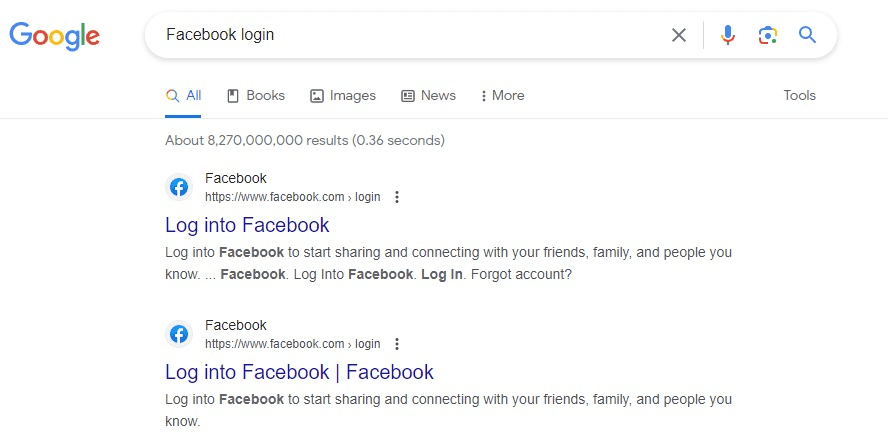[This is a test site and all posts are generated with ChatGPT unless indicated otherwise.]
In today’s digital landscape, search engines have become our compass, helping us navigate the vast realm of information. When we embark on a search, our intentions can vary widely. Sometimes, we seek information to quench our curiosity, other times we look for specific products or services to fulfill our needs. However, there’s a distinct search intent that often goes unnoticed but holds great significance – navigational search intent.
What is Navigational Search Intent?
Navigational search intent refers to a user’s desire to reach a particular website or web page by using a search engine. Rather than seeking general information or making a purchase, users with navigational intent already have a destination in mind. They turn to search engines as a convenient gateway to access their desired online location directly. These queries often include specific brand names, website URLs, or product names.
Understanding navigational search intent is vital for both users and businesses. For users, it ensures efficient and precise search results, saving time and effort in finding the desired website or information. It allows users to bypass the need for bookmarking or typing lengthy URLs directly into the address bar, making the search experience seamless.

For businesses and website owners, grasping navigational search intent is crucial to optimizing their online presence. By comprehending the motivations behind these queries, businesses can tailor their digital strategies to capture their target audience effectively. It enables companies to enhance brand visibility, improve user experience, and establish strong relationships with their customers.
Moreover, by recognizing the importance of navigational search intent, businesses can optimize their websites and content to ensure they appear prominently in search results when users search for their brand or offerings. This not only helps in driving relevant traffic but also reinforces brand recognition and fosters trust among users.
In the following sections, we will delve deeper into navigational search intent, exploring its characteristics, reasons behind its prevalence, and strategies to optimize for this intent. So, let’s embark on this journey to understand how navigational search intent can shape the online success of businesses and provide users with a seamless search experience.
Exploring Navigational Search Intent
In the vast digital realm, users often embark on their online journeys with a specific destination in mind. They seek the most efficient route to reach a particular website or web page, utilizing search engines as their virtual compass. This unique user behavior is known as navigational search intent.
Characteristics and features of navigational queries
- Brand-focused: Navigational queries often revolve around specific brand names, websites, or recognizable entities. Users include brand names, product names, or domain names in their search queries to find the desired website quickly.
- Direct access intent: Users with navigational intent are not seeking general information or exploring various options. Instead, they want to reach a specific website directly without the need for bookmarking or typing lengthy URLs into the address bar.
- Specificity: Navigational queries are typically precise and specific. Users include additional terms such as “official website,” “login,” “support,” or “contact” to refine their search and find the exact page or information they require.
- Intent clarity: Navigational queries display a clear intent. Users are not looking for alternatives or comparative information but are determined to access a particular website that fulfills their needs or expectations.
Examples of common navigational queries
Navigational queries come in various forms and cater to a wide range of user needs. Here are some common examples:
- “Facebook login”: Users who are familiar with Facebook and want to access their accounts directly use this query to reach the Facebook login page without navigating through multiple websites.
- “Amazon official website”: Users who want to shop on Amazon but prefer to access the official website directly often include this query to bypass potential confusion and find the genuine Amazon platform.
- “Nike store locator”: Users interested in finding nearby Nike stores employ this query to locate physical retail outlets or authorized dealers in their vicinity.
- “Netflix support”: Users encountering issues with their Netflix subscription or seeking assistance turn to search engines with this query to access the official support page of Netflix.
- “OpenAI GPT-3 documentation”: Developers or researchers interested in exploring OpenAI’s GPT-3 model often use this query to find the official documentation and resources related to GPT-3.
These examples highlight how navigational queries serve as a direct pathway to specific websites, brands, or information, making the search process more efficient for users.
Navigational search intent plays a significant role in users’ online navigation, allowing them to reach desired websites or web pages with ease. By understanding the characteristics and features of navigational queries, businesses can optimize their online presence to cater to this intent effectively. Recognizing and addressing common navigational queries ensures that brands and websites provide a seamless user experience, strengthen brand recognition, and foster trust among users seeking direct access to their desired destinations.
Reasons for Navigational Search Intent
Navigational search intent, where users seek to reach a specific website or web page through search engines, is a common behavior in the digital realm. Understanding the reasons behind navigational search intent is crucial for businesses aiming to enhance their online presence and user experience.
User motivations behind navigational queries
- Direct access: Users with navigational search intent are motivated by the desire for direct access to a known website or web page. They bypass other search intents and prioritize reaching a specific destination without unnecessary detours.
- Familiarity and trust: Users often exhibit navigational search intent when they are familiar with a brand or website and have prior positive experiences. They trust the brand and prefer accessing it directly rather than exploring alternative options.
- Efficiency and convenience: Navigational search intent arises from users’ preference for efficiency and convenience. Instead of manually typing lengthy URLs or searching through bookmarks, users leverage search engines as a quick and convenient gateway to access their desired online destinations.
Situations where users exhibit navigational search intent
- Brand recall: When users have previously interacted with a brand, whether through advertising, word of mouth, or prior visits, they are more likely to exhibit navigational search intent. They recall the brand and use search engines to navigate directly to its website for further engagement or transactions.
- Frequent visits: Users who frequently visit a particular website, such as social media platforms, e-commerce sites, or news outlets, tend to exhibit navigational search intent. They are accustomed to accessing the website’s content or services and rely on search engines to reach it efficiently.
- Complex URLs or domain names: Websites with complex URLs or domain names that are challenging to remember or type accurately often trigger navigational search intent. Users opt to search for the website’s name or related keywords to quickly navigate to their desired destination.
Importance of brand recognition and trust in navigational search intent
- Enhanced user experience: Navigational search intent is closely tied to brand recognition and trust. When users have a positive perception of a brand, they expect a seamless and familiar experience when accessing its website. Meeting these expectations through intuitive navigation, consistent branding, and personalized content enhances the overall user experience.
- Reinforced brand loyalty: Navigational search intent strengthens brand loyalty and fosters a sense of trust and reliability. When users consistently choose a brand’s website over alternatives, it reinforces their loyalty and increases the likelihood of repeat visits, conversions, and advocacy.
- Increased website traffic and visibility: Brands that successfully establish themselves as navigational destinations benefit from increased website traffic and visibility. Search engines recognize the popularity and relevance of these websites for specific queries, resulting in higher rankings and greater exposure to potential customers.
- Conversion opportunities: Users with navigational search intent are often closer to the conversion stage of the customer journey. By optimizing their websites to cater to this intent, brands can provide clear calls-to-action, streamline the conversion process, and capitalize on the higher likelihood of users completing transactions or desired actions.

Understanding the reasons behind navigational search intent is crucial for businesses seeking to optimize their online presence and user experience. By recognizing user motivations, identifying situations where navigational search intent arises, and emphasizing brand recognition and trust, businesses can effectively cater to users’ navigational needs, enhance brand loyalty, and capitalize on conversion opportunities. By providing a seamless, trusted, and efficient navigational experience, businesses can solidify their position as preferred destinations in the digital landscape.
Optimizing for Navigational Search Intent
As navigational search intent continues to shape user behavior in the digital world, businesses must optimize their online presence to cater to users seeking direct access to specific websites. By understanding the key elements of optimizing for navigational search intent, businesses can enhance their website’s navigability, improve user experience, and increase brand visibility. In this comprehensive guide, we will explore various strategies for optimizing your website to meet the needs of users with navigational search intent.
Ensuring your website is easily navigable
- Intuitive user interface: Create a user-friendly interface that allows visitors to easily navigate your website. Avoid clutter and excessive visual elements that may confuse or distract users.
- Consistent layout: Maintain a consistent layout across your website, ensuring that essential elements like the logo, search bar, and navigation menu are consistently positioned. This helps users familiarize themselves with your website’s structure and find what they’re looking for quickly.
- Responsive design: Optimize your website for different devices and screen sizes. A responsive design ensures that users can access your website seamlessly whether they’re using a desktop, laptop, tablet, or smartphone.
Creating a user-friendly website structure
- Clear information architecture: Organize your website’s content in a logical and hierarchical structure. Use categories, subcategories, and relevant labels to help users navigate through different sections and find specific pages or information easily.
- Search functionality: Implement a robust search feature that allows users to quickly search for specific content or pages within your website. Include filters and sorting options to refine search results further.
- Breadcrumbs: Incorporate breadcrumb navigation, displaying the user’s path and location within your website’s hierarchy. Breadcrumbs help users understand their current position and navigate backward if needed.
Implementing clear and intuitive navigation menus
- Clear labeling: Use descriptive labels for your navigation menu items. Clearly indicate the different sections or pages users can access through the menu to help them understand the content available and easily find what they’re looking for.
- Streamlined menu structure: Avoid overwhelming users with too many menu items. Keep the menu concise and organized, grouping related pages or sections together. Consider using drop-down menus for subcategories or additional options.
- Sticky navigation: Implement a sticky or fixed navigation menu that remains visible as users scroll through your website. This ensures that the menu is always accessible, allowing users to navigate to different sections without having to scroll back to the top.
Using branded keywords and terms
- Optimize page titles and meta descriptions: Incorporate your brand name or relevant keywords in page titles and meta descriptions. This helps search engines recognize your website as a navigational destination for users searching specifically for your brand.
- Brand-focused content: Create content that emphasizes your brand, its unique offerings, and features. Incorporate branded keywords and terms naturally throughout your website’s content, enhancing its visibility in search results.
- Schema markup: Implement schema markup for your brand to provide search engines with additional information about your business, such as your logo, social media profiles, contact information, and more. This helps search engines display rich snippets in search results, enhancing brand visibility.
Enhancing your online presence and brand visibility
- Consistent branding: Maintain consistent branding across all online platforms, including your website, social media profiles, email communications, and digital advertisements. Consistency reinforces brand recognition and helps users associate your brand with their desired destination.
- Local listings and directories: Ensure your brand is listed accurately in relevant local listings and directories. This improves your brand’s visibility and helps users find your website quickly when searching for your brand name in combination with location-specific keywords.
- Social media presence: Actively engage with your audience on social media platforms. Share valuable content, respond to inquiries, and promote your website as a reliable destination. This enhances your brand’s visibility and encourages users to navigate directly to your website.
Optimizing your website for navigational search intent is crucial for meeting the needs of users who already have a specific destination in mind. By ensuring your website is easily navigable, creating a user-friendly structure, implementing clear navigation menus, using branded keywords and terms, and enhancing your online presence and brand visibility, you can provide a seamless user experience and strengthen your position as a trusted navigational destination. By prioritizing the needs of users with navigational search intent, you can increase website traffic, improve brand recognition, and drive conversions.
Best Practices for Navigational Search Intent
To effectively cater to users with navigational search intent, businesses must implement best practices that optimize their online presence and deliver a seamless user experience
1. Conducting keyword research for navigational queries
- Brand and website-specific keywords: Identify keywords that are directly associated with your brand or website. Include variations of your brand name, domain name, and specific terms or phrases that users may search when seeking direct access to your website.
- Long-tail keywords: Focus on long-tail keywords that combine your brand or website name with specific qualifiers, such as product names, features, or services offered. These keywords help you target users with precise navigational intent.
- Competitor research: Analyze the keywords your competitors are targeting for navigational search intent. This can provide insights into common queries and help you refine your keyword strategy.
2. Creating informative and user-focused content
- Clear and concise landing pages: Design landing pages that provide users with the information they are seeking when accessing your website directly. Ensure that the landing pages are well-structured, easy to navigate, and contain relevant content that aligns with users’ expectations.
- Frequently asked questions (FAQs): Include an FAQ section on your website that addresses common queries users may have when navigating to your website. This helps provide clarity and ensures users find the information they need quickly.
- Knowledge base or support articles: Develop a comprehensive knowledge base or support section that covers various aspects of your brand, products, or services. This can assist users seeking specific information or troubleshooting guidance.
3. Utilizing structured data and rich snippets
- Implement schema markup: Utilize schema markup to provide search engines with structured data about your website, such as your brand name, logo, contact information, and social media profiles. This helps search engines understand and display relevant information in rich snippets, enhancing visibility and brand recognition.
- Rich snippets for site links: Implement structured data for site links to help search engines display additional navigational links within search results, directly pointing users to specific sections or pages of your website.
4. Monitoring and improving user experience metrics
- Analyze bounce rates: Monitor bounce rates to assess the effectiveness of your landing pages. High bounce rates may indicate that users are not finding what they expect or encounter difficulties navigating your website. Identify areas for improvement and optimize your pages accordingly.
- Page load speed: Ensure your website loads quickly across devices and networks. Slow-loading pages can frustrate users and lead to abandonment. Regularly optimize your website’s performance to deliver a smooth and efficient browsing experience.
- Mobile optimization: As mobile usage continues to rise, prioritize mobile optimization to accommodate users accessing your website on smartphones and tablets. Implement responsive design, optimize page layouts, and streamline navigation for mobile users.
Tracking and analyzing navigational search intent performance
- Set up goal tracking: Define specific goals related to navigational search intent, such as the number of users reaching your website directly, time spent on navigational pages, or conversions. Track these metrics to measure the success of your navigational search intent optimization efforts.
- Utilize analytics tools: Leverage analytics tools like Google Analytics to gain insights into user behavior, engagement, and conversions. Analyze data related to navigational search intent, such as top navigational queries, referral sources, and user flow within your website.
- User feedback and surveys: Collect user feedback to understand their navigational search intent experience. Conduct surveys or gather feedback through customer support channels to identify pain points and opportunities for improvement.
By implementing these best practices for navigational search intent, businesses can create a user-focused online experience that enhances brand engagement, drives website traffic, and fosters brand loyalty. Conducting keyword research, creating informative content, utilizing structured data, monitoring user experience metrics, and tracking performance are essential steps to optimize your website for users seeking direct access. By continuously refining your approach and prioritizing the needs of users with navigational search intent, you can elevate your brand’s visibility and deliver a seamless browsing experience that keeps users coming back.
Improving Your Online Visibility With Navigational Search Intent
Navigational search intent plays a significant role in user behavior and online engagement. Understanding and optimizing for this intent is crucial for businesses aiming to provide a seamless user experience and establish themselves as trusted navigational destinations. Here are the key takeaways for optimizing your content for navigational queries
Navigational search intent refers to users’ desire for direct access to a specific website or web page. It is driven by familiarity, trust, and the need for efficiency and convenience.
Future Trends and Considerations in Navigational Search Intent
As technology and user behavior continue to evolve, it is important to stay updated on future trends and considerations in navigational search intent. Some areas to watch include:
- Voice search and its impact on direct website access.
- The rise of mobile usage and the need for seamless mobile experiences.
- Personalization and customization to cater to individual user preferences.
- The growing importance of brand recognition and trust in navigating online experiences.
By implementing these strategies and staying aware of emerging trends, businesses can effectively optimize their content for navigational search intent and deliver a superior user experience that fosters brand loyalty and drives meaningful engagement.


